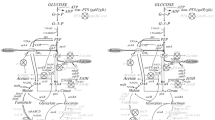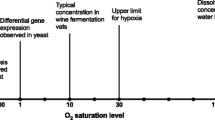Summary
The anaerobic glucose uptake (at 20°, pH 3.5) by resting cells of Saccharomyces cerevisiae followed unidirectional Michaelis-Menten kinetics and was competitively inhibited by l-sorbose; K m and K i were respectively 5.6×10-4 m and 1.8×10-1 m; V max was 6.5×10-8 moles mg-1 min-1. The aerobic uptake of glucose by resting yeast was also inhibited by l-sorbose but did not follow unidirectional Michaelis-Menten kinetics. Glucose-limited growth in the chemostat of a respiration-deficient mutant of S. cerevisiae was competitively inhibited by l-sorbose. As predicted by theory for transport-limited growth in the chemostat (van Uden, 1967) the steady state glucose concentrations were linear functions of the l-sorbose concentrations with different slopes at different dilution rates; K m and K i were respectively 7.2×10-4 m and 1.8×10-1 m. It is concluded that glucose transport was the rate-limiting step of anaerobic fermentation of S. cerevisiae and of growth of the mutant and that l-sorbose is a competitive inhibitor of active glucose transport in this yeast. The latter conclusion is accommodated in the transport model of van Steveninck and Rothstein (1965).
Similar content being viewed by others
References
Andreasen, A. A., and T. J. B. Stier: Anaerobic nutrition of Saccharomyces cerevisiae. I. Ergosterol requirement for growth in a defined medium. J. cell. comp. Physiol. 41, 23–36 (1963).
Augustin, H. W., G. Kopperschläger, H. Steffen, u. E. Hofmann: Hexokinase als begrenzender Faktor des anaeroben Glucoseverbrauches von Saccharomyces carlsbergensis NCYC74. Biochim. biophys. Acta (Amst.) 110, 437–439 (1965).
Brown, D. H.: The phosphorylation of d-(+)-glucosamine by cristalline yeast hexokinase. Biochim. biophys. Acta (Amst.) 7, 487–493 (1951).
Bulder, C. J. E. A.: On respiratory deficiency in yeasts. PhD. Thesis, Technical University of Delft, Netherlands 1963.
Cirillo, V. P.: The mechanism of sugar transport into the yeast cell. Trans. N.Y. Acad. Sci. 23, series II, 725–734 (1961).
—: Mechanism of glucose transport across the yeast cell membrane. J. Bact. 84, 485–491 (1962).
Fuente, G. de la, and A. Sols: Transport of sugars in yeasts. II. Mechanisms of utilization of disaccharides and related glycosides. Biochim. biophys. Acta (Amst.) 56, 49–62 (1962).
Gutz, H.: Zur Entstehung von atmungsdefekten Mutanten bei einem Stamm von Saccharomyces carlsbergensis. Naturwissenschaften 44, 545 (1957).
Nagai, S.: Diagnostic color differentiation plates for hereditary respiration deficiency in yeast. J. Bact. 86, 299–302 (1963).
Okada, H., and H. O. Halvorson: Uptake of α-thioethyl d-glucopyranoside by Saccharomyces cerevisiae. I. The genetic control of facilitated diffusion and active transport. Biochim. biophys. Acta (Amst.) 82, 538–546 (1964a).
: Uptake of α-thioethyl d-glucopyranoside by Saccharomyces cerevisiae. II. General characteristics of an active transport system. Biochim. biophys. Acta (Amst.) 82, 547–555 (1964b).
Rothstein, A.: Active transport and secretion. Symp. Soc. exp. Biol. 8, 165–201 (1954).
Steveninck, J. van: The influence of nickelous ions on carbohydrate transport in yeast cells. Biochim. biophys. Acta (Amst.) 126, 154–162 (1966).
—, and H. L. Booij: The role of polyphosphates in the transport mechanism of glucose in yeast cells. J. gen. Physiol. 48, 43–60 (1964).
—, and A. Rothstein: Sugar transport and metal binding in yeast. J. gen. Physiol. 49, 235–246 (1965).
Sols, A., G. de la Fuente, C. Villar-Palasi, and C. Asensio: Substrate specific and some other properties of baker's yeast hexokinase. Biochim. biophys. Acta (Amst.) 30, 92–101 (1958).
Uden, N. van: Transport-limited growth in the chemostat and its competitive inhibition; a theoretical treatment. Arch. Mikrobiol. 58, 145–154 (1967).
—, and M. Farinha: On the significance of temperature relations and vitamin deficiency patterns in the delimination of yeast species. Port. Acta Biol. 6, ser. B, 161–178 (1958).
Umbreit, W. W., R. H. Burris, and J. F. Stauffer: Manometric techniques. 4th ed. Minneapolis, Minnesota: Burgess Publishing Comp. 1964.
Wickerham, L. J.: Taxonomy of yeasts. Techn. Bull. No. 1029, U.S. Dept. Agric. Washington, D. C. 1951.
Wilbrandt, W., and T. Rosenberg: The concept of carrier transport and its corollaries in pharmacology. Pharmacol. Rev. 13, 109–183 (1961).
Wilkins, P. O., and V. P. Cirillo: Sorbose counterflow as a measure of intracellular glucose in baker's yeasts. J. Bact. 90, 1605–1610 (1965).
Ycas, M.: A hereditary cytochrome deficiency appearing in yeast grown at an elevated temperature. Exp. Cell Res. 10, 746 (1956).
Author information
Authors and Affiliations
Rights and permissions
About this article
Cite this article
van Uden, N. Transport-limited fermentation and growth of Saccharomyces cerevisiae and its competitive inhibition. Archiv. Mikrobiol. 58, 155–168 (1967). https://doi.org/10.1007/BF00406676
Received:
Issue Date:
DOI: https://doi.org/10.1007/BF00406676




